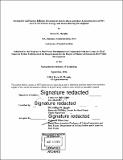Sustainable and energy-efficient development interventions and their application toward net-zero or net-positive energy and water building development
Author(s)
Murphy, Kevin M. (Kevin Michael)
DownloadFull printable version (10.46Mb)
Other Contributors
Massachusetts Institute of Technology. Center for Real Estate. Program in Real Estate Development.
Advisor
Andrea M. Chegut.
Terms of use
Metadata
Show full item recordAbstract
The built environment consumes more than 40% of the energy used around the world and nearly 70% of the electricity used in the United States. These same buildings use 25% of the world's fresh water resources and contribute 50% of global waste. In order to make the buildings we inhabit more resource-efficient, strategies are being employed through the use of technology, materials, and design in order to achieve a new standard of environmental impact, called net-zero buildings. To date, only a few dozen buildings in the United States have achieved net-zero or net-positive energy and water status, where they capture as much or more energy and water through renewable energy resources and water collection and reuse mechanisms as they use on an annual basis. This thesis examines the many energy- and water-efficient systems, design solutions, and materials that work together to create more sustainable structures and presents case studies for two highly-efficient developments. These net-zero interventions are then compared to the highest-scoring Leadership in Energy and Environmental Design (LEED) buildings across the United States in an attempt to detail the similarities and differences in the goals of each system. Research of the top 10 highest-rated investor-owned buildings shows a significant gap in performance between the systems and design elements used to achieve LEED Platinum status and the energy and water interventions that are necessary to reach net-zero consumption goals. The gap in performance between LEED and net-zero design is related to regulatory hurdles, technological advancements, and the sophistication of design teams. Combined, these influence the commercial diffusion of net-zero development projects and can be used to understand how the built environment can start to meet sustainability goals.
Description
Thesis: S.M. in Real Estate Development, Massachusetts Institute of Technology, Program in Real Estate Development in conjunction with the Center for Real Estate, June 2017. "September 2016." Cataloged from PDF version of thesis. Includes bibliographical references (page 94).
Date issued
2017Department
Massachusetts Institute of Technology. Center for Real Estate. Program in Real Estate Development.; Massachusetts Institute of Technology. Center for Real EstatePublisher
Massachusetts Institute of Technology
Keywords
Center for Real Estate. Program in Real Estate Development.